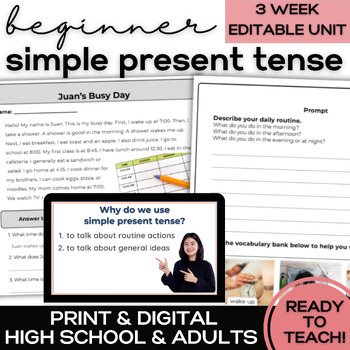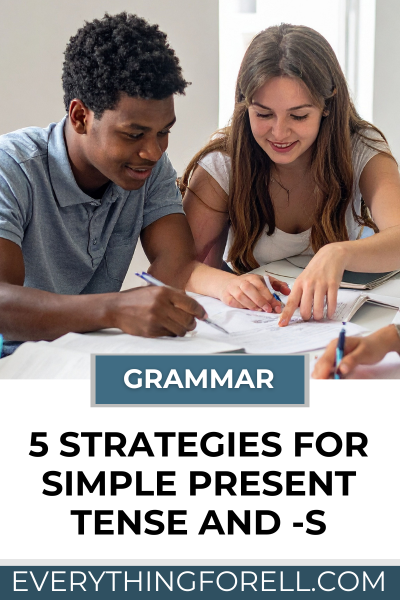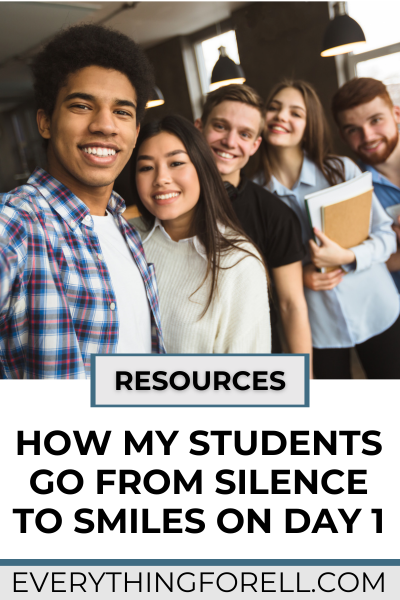The most common mistake I see with the simple present tense, even among my more advanced students, is dropping the -s in the present simple tense when talking about he, she, or it.
So after 15 years of teaching, here are my five classroom tested techniques that help students think it, see it, hear it, and say it, so the -s sticks.
1. Practice Simple Present with Pronouns First
Before students focus on simple present tense verb endings, they need to clearly understand who they’re talking about. I spend time helping students replace names and nouns with the correct pronouns. Many learners forget that a person’s name or an object functions exactly like he, she, or it, and this is often where the missing -s begins.
Looks like: When we practice as a class, I underline the name in a sentence and ask students which pronoun replaces it:
- “Is my mom an I, you, he, or she?”
When students answer she, I write it above my mom.
I also use a simple sorting activity with three categories that can be done as board work or as a physical word sort. Students sort nouns into the correct category: he/she, it, or they. I truly feel like building this bridge in our students’ minds is the first step into making sure they add the -s in the third person singular.
2. Someone else?
Students also often forget the -s in the simple present tense when they thinking too quickly. This strategy teaches them to pause and identify who the sentence is about before they answer.
Looks like: I ask, “Is this sentence about others or someone else?
- If the subject is someone else (a single other person), that’s their cue to add the -s.
If the subject is others (plural people), they know not to add it.
This approach shifts the focus from grammar rules to simply recognizing who the speaker is talking about, which works better for some of our students.
3. The “S” Visual
Looks like:
In my early teaching years, I cut out a giant red S, taped it to a ruler, and used it as a visual reminder. Surprisingly, my secondary students loved it. It became a fun strategy for the simple present tense that helped make corrections playful rather than intimidating.
- When students go to the board to read sentences aloud, they get to lift the S-stick if their verb needs the -s on the end.
- When I check their written work, if they miss an -s, I simply tap their desk with the giant S and ask them to look again.
- If a student drops the -s while speaking, I raise the S-stick, and the entire class shouts “S!”
It becomes a fun way to learn, and because the moment is memorable, the rule becomes memorable too.
4. The “S” Sound Hunt
Once students understand the rule for the simple present tense, they need to hear the -s consistently in natural language.
Looks like:
- I read a short, teacher-made paragraph written in the present simple about a person. Each time students hear a verb with the 3rd-person -s, they raise their hand or hold up their own S card.
This helps train their ears to recognize the correct ending. When students can hear the -s clearly, they are much more likely to use it correctly. More importantly, they begin noticing when it’s missing, even in their own speech, and self-correct.
5. Exaggerate and Drill
I am combining these two idea together. While teaching the simple present tense, I exaggerate the -s sound during practice. This makes the sound more noticeable and helps students catch themselves before making a mistake. I also ask many questions that require them to respond with a verb that takes the -s.
Looks like:
- During class board practice, I exaggerate the -s sound and expect students to echo it.
- During reading, I exaggerate the -s in verbs. I also do this when asking questions that use does, which signals to students that their response must include the -s.
I also use simple listening and speaking activities to strengthen this habit. Students will grab a question card, and the exchange looks a little like this:
- Student A: What time do you eat breakfast?
- Student B: I eat breakfast at 8:30.
- Student C: She eats breakfast at 8:30.
Flipping between the two uses of present simple helps build fluency.
Final Thoughts on the Simple Present Tense 💭
These five strategies help students think about who they’re talking about, identify -s being used correctly, and then hear and speak -s clearly. This repetition throughout a simple present tense unit builds the confidence needed for students to use the -s ending automatically.
In fact, my simple present tense unit builds fluency in all 4 domains of language while lending itself to easily implement these strategies. 3 weeks of lessons with an assessment that build the foundation your students need to successfully move forward in their English learning.
Simple Present Tense – Grammar Lessons for Newcomer High School and Adult ESL
Grammar worksheets won’t build fluency! These 14 lessons with simple present activities are planned and prepared to include everything your newcomer or beginner English language learners need to develop their listening, speaking, reading, and writing skills!
Teaching the present simple tense -s can easily be overlooked because it is frustrating to constantly point out. However, these 5 small techniques can make a big difference.
What strategies have you used to help students remember the -s? Let me know in the comments below, so we can learn as a community!
👉 Need more beginner ESL strategies? Check them out here!
















